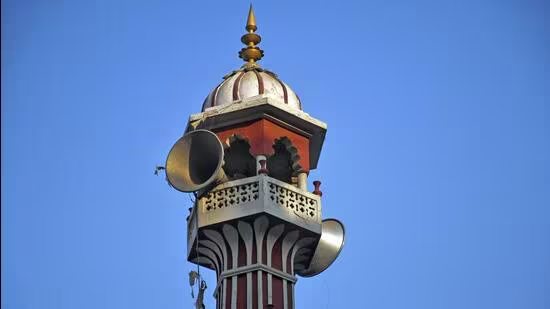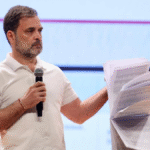Loudspeaker Ban Petition in Bombay High Court: Concerns Over Law and Order
The Bombay High Court is set to examine a petition challenging the recent loudspeaker ban that, according to petitioners, could spark significant law and order problems across Maharashtra. The Public Interest Litigation (PIL) argues that removing loudspeakers from religious and community spaces without a structured implementation plan risks inflaming tensions in an already sensitive socio-political climate.
The petition highlights that loudspeakers have been an integral part of religious and cultural practices for decades, used for prayer calls, festival announcements, and community gatherings. While acknowledging the need for noise regulation to protect public health and maintain peace, the petitioner stresses that abrupt enforcement—especially during peak religious periods—could trigger unrest among communities that feel unfairly targeted.
Central to the PIL is the argument that the ban disproportionately affects minority communities. It claims that the decision appears to be selective in its enforcement, creating a perception of bias and discrimination. “This is not merely about sound decibels; it is about the social harmony of our state,” the petition notes, urging the court to direct the government towards a phased, consultative approach instead of immediate blanket bans.
From the administrative side, authorities argue that the measure is in line with Supreme Court guidelines on permissible noise levels, particularly during nighttime hours. Officials emphasize that the objective is to safeguard citizens’ right to a peaceful environment, not to infringe upon religious freedom. However, the challenge lies in balancing the constitutional right to practice religion with the equally fundamental right to live without noise pollution.
The petition warns that without clear communication, transparent guidelines, and community dialogue, the ban could become a flashpoint for law and order disturbances. It cites past incidents where restrictions on public religious practices led to protests, road blockages, and clashes between groups, straining police resources and escalating political rhetoric.
As the matter comes up for hearing, legal experts believe the case could set a precedent on how noise control laws are enforced in India, particularly in urban centers with dense, diverse populations like Mumbai. The outcome may shape not only the operational limits of loudspeakers but also the broader legal boundaries between public order, religious expression, and environmental health.
The loudspeaker debate in India is not new. For decades, it has been a point of contention between religious communities, civic bodies, and environmental activists. The issue often flares up during major festivals, religious observances, and political events, where amplified sound plays a central role in drawing crowds and creating a sense of unity.
Historically, the first major legal interventions on loudspeaker use emerged in the early 2000s, when courts across several states began enforcing noise pollution regulations under the Environment Protection Act, 1986, and relevant state-level noise control rules. The Supreme Court, in landmark rulings, set maximum permissible noise levels and prohibited the use of loudspeakers between 10:00 pm and 6:00 am, except in cases of special permissions for certain festivals or events.
In Maharashtra, the matter has repeatedly returned to the forefront, particularly in Mumbai, Thane, and Pune — cities with dense populations and diverse religious demographics. Here, the challenge has always been to balance cultural vibrancy with urban residents’ right to rest. Many citizens complain about loudspeakers disrupting sleep, affecting children’s studies, and contributing to health issues such as hypertension and stress.
At the same time, religious institutions argue that loudspeakers have become deeply embedded in spiritual practices. For example, mosques use them for the azaan (call to prayer), temples for aarti announcements, and churches for bells and hymns. Removing or limiting this practice is often perceived as an attempt to dilute cultural identity.
Past attempts at strict enforcement have sometimes led to significant unrest. In 2018, for instance, when authorities in certain districts of Maharashtra clamped down on loudspeaker use without prior community engagement, small-scale protests broke out. These incidents underscored the importance of building consensus before implementing restrictions.
The current petition before the Bombay High Court builds upon this historical backdrop, warning that without careful handling, the situation could mirror past episodes of tension. It urges the judiciary to consider phased enforcement, noise-level monitoring technology, and community-led compliance mechanisms, rather than blanket bans.
In this context, the case is more than a legal dispute; it is a test of India’s capacity to harmonize public order with cultural expression. As one senior legal analyst puts it, “This is not merely about decibels. It’s about the pulse of society — and how that pulse can be regulated without stopping the heartbeat.
The ongoing loudspeaker dispute has opened a complex legal battlefield, where both petitioners and respondents are framing their arguments within the boundaries of India’s constitutional framework and existing statutory provisions.
Petitioners’ Perspective
The petitioners before the Bombay High Court contend that an outright ban or severe restriction on loudspeakers could trigger social unrest and law-and-order issues. Their arguments are rooted in several key points:
- Freedom of Religion (Article 25 of the Constitution)
They argue that the use of loudspeakers, while not explicitly mandated by any religion, has become an intrinsic part of religious expression. Under Article 25, citizens have the right to freely profess, practice, and propagate their religion, subject to public order, morality, and health. The petitioners maintain that loudspeaker use falls under the “practice” element, as it facilitates collective worship. - Equality Before Law (Article 14)
A major concern is selective enforcement. Petitioners claim that restrictions often appear to target certain religious groups more stringently, which they argue violates the principle of equality before law. - Potential for Public Disorder
The petition emphasizes that any sudden or unbalanced enforcement could be perceived as religious discrimination, which might provoke protests, damage inter-community trust, and escalate tensions. - Alternative Solutions
Instead of bans, the petitioners propose measures like decibel-based monitoring, fixed duration permissions, and soundproofing equipment. They highlight that technological tools like directional speakers and real-time noise monitors can help ensure compliance without infringing on rights.
Respondents’ Perspective
On the other side, the state government and civic authorities defend their stance by invoking public welfare and environmental considerations.
- Right to a Peaceful Environment (Article 21)
The state argues that Article 21, which guarantees the right to life, implicitly includes the right to live in an environment free from excessive noise. Several Supreme Court rulings have recognized noise pollution as a violation of this fundamental right. - Statutory Provisions on Noise Pollution
The Environment Protection Act, 1986, along with the Noise Pollution (Regulation and Control) Rules, 2000, prescribes strict norms on permissible noise levels in residential and silent zones. The government maintains that loudspeakers often exceed these thresholds, especially during nighttime. - Health and Safety Concerns
Citing studies from the World Health Organization, the respondents argue that prolonged exposure to loud noise can cause hearing loss, sleep disturbances, cardiovascular problems, and reduced cognitive performance. They stress that protecting citizens’ health outweighs the convenience of amplified sound. - Precedent Rulings
Authorities reference Supreme Court judgments, such as In Re: Noise Pollution (2005), where the court upheld restrictions on loudspeakers, even for religious events, citing public health and order.
Balancing the Two Sides
The High Court is now tasked with reconciling two competing fundamental rights — the right to religious expression and the right to a peaceful environment. Legal experts suggest that the decision may hinge on whether the court views loudspeaker use as an essential religious practice or a cultural convenience that can be regulated.
Past judgments indicate that courts have generally leaned towards regulation when public health is at stake, but have also cautioned against discriminatory enforcement. This means the court could opt for a middle path — allowing restricted use within defined decibel limits and hours, monitored by neutral enforcement bodies.
While the loudspeaker dispute may appear on the surface to be a matter of law and public health, its undertones are deeply political. In India’s highly charged electoral climate, religious identity, public sentiment, and symbolic issues often intersect with governance decisions — and the loudspeaker ban debate is no exception.
The Political Playbook
Political analysts note that noise control laws are not new, nor are they targeted exclusively at religious institutions. However, when enforcement is perceived as selective, it can create fertile ground for political narratives.
- Polarization Potential
In a multi-religious society, any restriction linked to religious expression can become a rallying point for both majoritarian and minority politics. Parties seeking to consolidate their vote banks often frame such issues as either “protecting traditions” or “defending citizens’ rights to peace.” - Symbolic Significance
Loudspeakers, while technically just sound-amplifying devices, carry symbolic weight — especially in the context of calls to prayer, devotional music, and festival announcements. Political parties understand that any policy involving them can be presented as a stand for cultural identity or secular enforcement.
Statements from Key Leaders
Several political leaders have already begun weighing in on the matter:
- Pro-Regulation Voices
Some leaders from ruling and opposition parties alike argue that regulations are necessary for maintaining communal harmony and preventing unnecessary disturbances. They present this as a governance and quality-of-life issue, distancing it from religious connotations. - Opposition Arguments
Leaders in opposition or from minority-representing parties frame the ban as a direct infringement on religious freedoms. They highlight past instances where other community practices were left unchecked, alleging a double standard in enforcement.
Past Precedents in Political Mobilization
The loudspeaker debate has parallels with previous controversies in India’s political landscape:
- The 2002–2003 Noise Control Drives
Similar restrictions in Maharashtra two decades ago led to large-scale protests, with several political organizations positioning themselves as protectors of cultural and religious traditions. - Election Season Amplification
During election years, symbolic issues tend to receive more attention in speeches, rallies, and media coverage. Political parties understand that such emotionally resonant topics can influence voter turnout and sentiment.
Impact on Upcoming Elections
With municipal and state elections approaching in Maharashtra, strategists predict that the loudspeaker issue will likely be woven into campaign narratives:
- For Urban Voters: The emphasis may be on noise pollution control, quality of life, and balanced governance.
- For Rural and Semi-Urban Voters: The rhetoric could shift towards protecting traditions and religious customs from perceived encroachments.
- For Youth Demographics: Campaigns may focus on modernization, technology-based solutions, and legal equality.
The Risk of Escalation
While political capital can be gained from energizing voter bases through such issues, there is also the danger of deepening social divides. Analysts caution that excessive politicization could make it harder for courts and administrators to implement neutral, effective solutions.
The debate over loudspeakers in public and religious spaces is not a new phenomenon. It has evolved over decades in India and across the world, shaped by technological changes, urban growth, religious diversity, and shifting legal frameworks.
The Evolution of Noise Regulation in India
India’s noise control laws have gradually developed from broad public order provisions to more specific, decibel-based regulations.
- Pre-Independence Era
During the British colonial period, local municipal acts and police powers governed public disturbances, including sound amplification. Loudspeakers were a rare technology, so legal disputes were minimal. - Post-Independence Phase (1950s–1970s)
The spread of electrical loudspeakers for public announcements, political campaigns, and religious purposes created new challenges. Local governments began issuing orders regulating their use, often linked to festivals or election rallies. - Judicial Intervention in the 1990s
As urbanization increased, noise pollution became a recognized public health concern. Landmark Supreme Court and High Court judgments laid the groundwork for specific restrictions, including the 10 p.m. to 6 a.m. ban on loudspeakers. - Modern Framework (2000s–Present)
The Noise Pollution (Regulation and Control) Rules, 2000, under the Environment Protection Act, created a structured approach, specifying maximum permissible decibel levels in residential, commercial, industrial, and silence zones. The rules applied to all sound sources, including religious institutions, political rallies, and entertainment venues.
Notable Court Rulings
Several court rulings have shaped how India handles loudspeaker-related disputes:
- Church of God (Full Gospel) in India v. K.K.R. Majestic Colony Welfare Association (2000)
The Supreme Court held that no religion mandates the use of loudspeakers and that citizens have the right to live in an environment free from unnecessary noise. - In Re: Noise Pollution (2005)
The apex court reinforced the 10 p.m. to 6 a.m. loudspeaker ban and emphasized that religious freedom under Article 25 of the Constitution is subject to public order, morality, and health.
These decisions have consistently clarified that religious expression is protected, but it cannot override environmental and health laws.
Comparative Global Practices
India is far from the only country to face debates over amplified sound in public spaces.
- United Kingdom
Local councils regulate noise through the Environmental Protection Act. Religious institutions must comply with specific decibel limits, with enforcement through fines or court orders. - Indonesia
In 2022, the Ministry of Religious Affairs issued guidelines limiting mosque loudspeaker volume, citing neighborly harmony and public comfort. The decision sparked debates similar to those seen in India. - United States
Noise regulation is largely handled at the city or county level. While the First Amendment protects religious freedom, most municipalities enforce time, place, and manner restrictions to balance community peace with expression rights. - Saudi Arabia
In 2021, the government restricted mosque loudspeaker volume to one-third of its maximum capacity, aiming to reduce noise in residential areas.
Lessons from International Approaches
The key takeaway from global examples is that successful noise regulation typically rests on:
- Clear, uniform rules applied equally to all groups.
- Transparent enforcement to prevent allegations of bias.
- Public consultation before implementing major changes.
- Technological solutions — such as directional speakers or mobile app-based prayer alerts — to balance tradition with modern living standards.
India’s Unique Challenge
Unlike more homogenous societies, India’s diversity means any regulation must navigate not just legal and health concerns but also deep cultural sensitivities. Balancing constitutional freedoms with the right to peace and quiet requires continuous dialogue between governments, courts, religious leaders, and communities.
Public Health Implications and Scientific Research on Noise Pollution
Noise is often dismissed as a minor inconvenience, but research has shown that chronic exposure to high-decibel environments can have profound and lasting effects on human health. The loudspeaker debate in India intersects not only with cultural and religious issues but also with urgent public health concerns.
The Science of Sound and Health
The World Health Organization (WHO) defines noise pollution as unwanted or harmful outdoor sound created by human activities, such as traffic, industry, or public events. Loudspeakers, particularly when used at high volume over long periods, can contribute to environmental noise levels that surpass safe thresholds.
- Safe Limits
WHO guidelines recommend that outdoor noise levels should not exceed 55 decibels during the day and 40 decibels at night to protect against adverse health effects. Loudspeakers often operate well above these levels, especially during festivals, political rallies, or extended religious ceremonies.
Physical Health Effects
Scientific studies have identified multiple physical consequences of prolonged exposure to noise pollution:
- Hearing Loss
Exposure to noise above 85 decibels for extended periods can cause irreversible hearing damage. Festivals or processions with loudspeakers often exceed 100 decibels, posing significant risks. - Cardiovascular Diseases
Chronic noise exposure has been linked to hypertension, heart disease, and increased risk of stroke. The body responds to noise as a stressor, triggering hormonal changes that strain the cardiovascular system. - Sleep Disturbance
Night-time loudspeaker use disrupts sleep cycles, leading to fatigue, reduced concentration, and weakened immunity. For children and the elderly, these effects can be particularly harmful. - Pregnancy Complications
Research has suggested that excessive noise exposure during pregnancy can contribute to low birth weight and preterm delivery, as well as delayed cognitive development in infants.
Mental Health Consequences
Beyond physical effects, noise pollution exerts a significant psychological toll:
- Stress and Anxiety
Persistent loud noise can elevate stress hormones like cortisol, leading to chronic anxiety and irritability. - Reduced Cognitive Performance
Studies show that children in noisy environments have lower reading comprehension, memory retention, and problem-solving skills compared to those in quieter settings. - Social Conflict
High noise levels, especially when linked to cultural or religious practices, can fuel tensions between communities, eroding social cohesion.
Expert Opinions
- Medical Perspective
Dr. Arvind Kumar, a public health expert, notes that “noise pollution is the invisible killer of modern urban life. While it doesn’t leave immediate scars, its impact on the body and mind is cumulative and devastating.” - Environmental Advocacy
Environmentalists argue that India’s approach to noise control should be as robust as its campaigns against air and water pollution, emphasizing that the right to peace and quiet is a fundamental component of environmental justice.
Technological Solutions
Advances in sound engineering can help strike a balance between tradition and health:
- Directional Loudspeakers
These focus sound towards a specific audience area, reducing noise spill into surrounding neighborhoods. - Volume Governors
Devices that limit maximum output to a safe decibel level. - Digital Alerts
Religious institutions can explore smartphone app notifications for prayer times or festival announcements, reducing dependence on high-volume amplification.
Policy Recommendations
Based on WHO guidelines and expert advice, policymakers could consider:
- Mandatory decibel checks before granting permissions for loudspeaker use.
- Time-bound permits with strict penalties for violations.
- Awareness campaigns highlighting health risks of noise pollution.
- Investment in technology for safer sound management.
Also Read : 5 Explosive Takeaways from Rahul Gandhi’s ‘Atom Bomb’ Proof Alleging Massive Vote Chori








